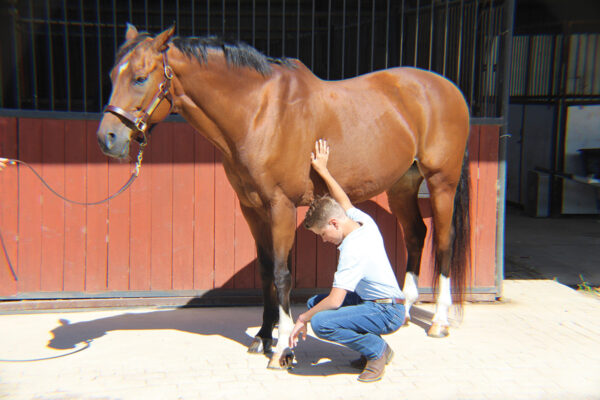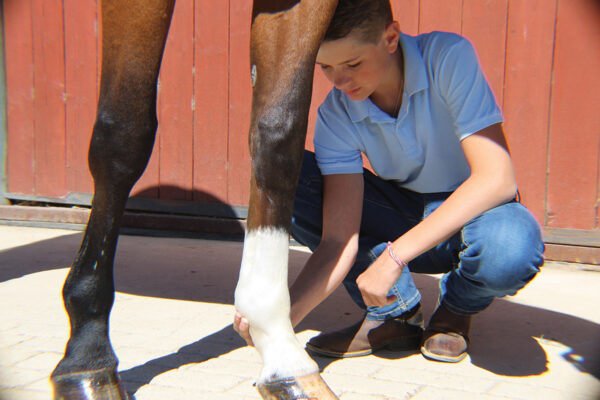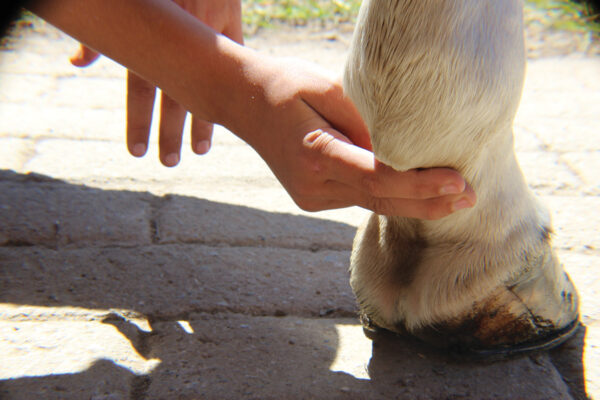Though you may have seen a vet take your horse or pony’s pulse by feeling under his jaw, that’s not the only place his heart rate can be felt—you can also find his pulse on his legs. A horse’s pulse measures the rate and strength of his heartbeat; the pulse that can be felt on a horse’s leg is called his digital pulse.
It’s important to be able to find the digital pulse because it can offer you clues to your horse’s overall health. A digital pulse tells you how the blood is flowing to the horse’s hooves. Digital pulses are often faint, but if the pulse is very strong, and it feels like the blood is rushing (“bounding’”) to his legs, there may be something wrong.
Your horse might have a strong pulse for a variety of reasons, including excitement, exertion or stress, but a strong pulse in his leg (or legs) could indicate something is amiss. He may have a hot nail (a horse shoe nail that’s too close to the sensitive tissues within the hoof), an abscess or a bruise, or he may be suffering from laminitis. The pulse in his legs feels stronger when there’s inflammation, making it harder for the blood to flow further down his legs.
The Digital Pulse
Finding your horse’s digital pulse isn’t hard, but it can take some practice to find easily. You should practice taking your horse’s pulse to become familiar with what’s normal for him.
Before you begin to work around your horse’s legs, tie him safely or have a helper hold him so you’re not chasing him around or putting yourself in harm’s way. Never stand directly in front of a horse as you’re finding his pulse—you don’t want him to accidentally run you over if he spooks or moves.

The digital pulse can be felt on both the inside and outside of the leg, just above the fetlock, over the fetlock and down the pastern. There are multiple places where you can check a horse’s digital pulse, but we will focus on where the artery runs over the fetlock. To find the digital pulse here, follow these steps:
◆ Step One: Squat and run your hand down the back of the horse’s leg, starting at the back of his knee or his hock. Stop when you reach his fetlock.

◆ Step Two: Slide your index and middle fingers around to just inside his fetlock. Feel for the soft, squishy area and press slightly harder to locate what feels like guitar strings—these are the digital arteries.

◆ Step Three: Press until you feel his pulse and time the beats for 10 to 15 seconds; multiply by 6 or 4, respectively, to calculate the pulse rate in beats per minute (BPM).
If you can’t find the pulse, adjust how hard you’re pressing; pressing too hard will cut off the blood flow and you won’t feel the pulse. Pressing too softly won’t allow you to feel the pulse at all.
◆ Step Four: Pay attention to how the pulse feels so you can compare it in his three other legs.
If you’re struggling to find the digital pulse, ask your instructor, a veterinarian or a knowledgeable adult to show you how to locate it. It can be tricky to find, but it’s important to know how to locate this pulse and what “normal” feels like so you can keep your horse healthy!
This is especially important if your horse has a history of metabolic issues (like Cushing’s disease) that may make him prone to founder. A bounding digital pulse is often the first clue that your horse has something wrong and that he’s in the first stages of foundering.
Pulse Tips
◆ An adult horse’s heart rate should be (on average) between 30 and 40 beats per minute. Keep this number in mind when checking for digital pulses.
◆ Finding a horse’s digital pulse can be tough—and that’s OK! Digital pulses are often faint in healthy horses.
◆ While you’re feeling for the pulse, be sure to feel your horse’s hooves, as well. The hooves should all feel about the same temperature; a hoof that is overly hot means that something is amiss.
◆ Take the pulse in each of your horse’s legs, not just one.
◆ Consider checking your horse’s digital pulse each time you groom.
Special thanks to Austin Cahill for demonstrating this skill!
This article about how to take a digital pulse appeared in the January/February 2023 issue of Young Rider magazine. Click here to subscribe!


